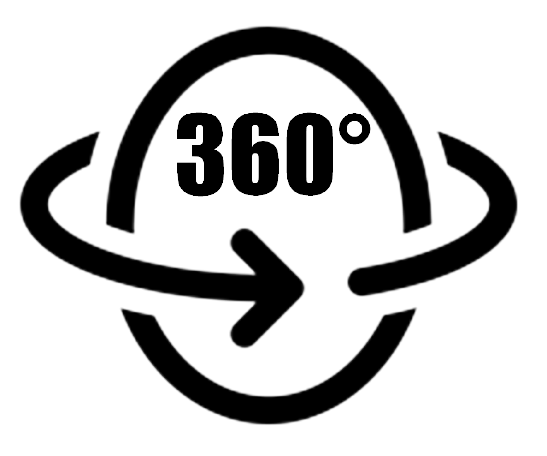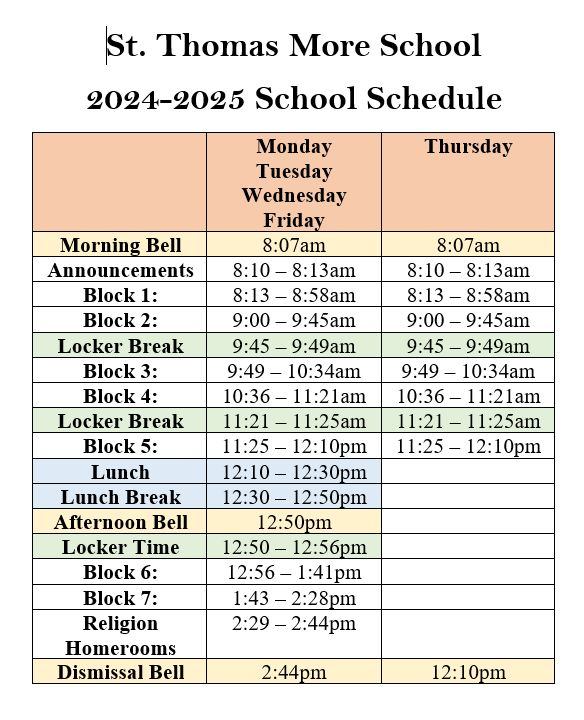
At St. Thomas More, we are completely committed to the development of a student’s mind, body and spirit! We are blessed with excellent teachers and instructors and the success of our alumni speaks to the excellent quality of our academic and academy programing. Further, given our understanding in the many benefits of physical activity, including improved mental health, all our students access our exemplary training programs through their academy instructors or physical education and health teachers.
As we all know, Junior High is more than academics. With our wide range of Options (including Recreation Leadership, Cree Language, French, Spanish, Art, Band, Construction, Film, Foods, and Digital design/Robotics), our Leadership & Social Justice initiatives, and our high-achieving Athletic Teams, your child will have ample opportunity to meet new friends and to seek the excellence within!
360 Tour of STM
Open House
Open House January 30, 2025
Inclusive Communities/School Conduct/Student Standard of Dress
Inclusive Communities
Edmonton Catholic Schools is committed to providing an inclusive, welcoming, caring, respectful, safe, and Catholic environment that promotes the well-being of all and fosters community support for achieving this goal. We acknowledge that everyone is responsible for creating and upholding an environment where all are welcome and where promoting the dignity and rights of each and every person is established. The following policy, administrative procedures and student code of conduct outline the expectations of all stakeholders in creating a place where everyone is welcomed and valued.
Grounded in our Catholic faith we believe:
All students are created in the image and likeness of God. As such, all human beings are inherently sacred and must be treated with dignity and respect. All efforts to support a welcoming, inclusive, respectful, safe, and caring learning environment within our school, in accordance with the teaching of the Catholic Church, remains central to our mission (Administrative Policy 138).
Guiding Principles:
Honesty takes courage and is always rooted in truth. As part of our human weakness we all make mistakes. In order for growth to occur we are all called by our Heavenly Father to learn from our mistakes and be accountable for our words and actions. Integrity and trust is rooted in truth and honesty.
Respect and Dignity must permeate all that we say and do whether in our words, deeds, or actions.
Reverence of the Catholic faith is permeated in all aspects of our school life. We participate in the traditions of our faith so that we might grow as children of God. We are called to be attentive to our personal and communal Catholic identity. In times of distress we are called to reflection and prayer so that the guiding wisdom of the Holy Spirit be ever present in all of our relationships.
Responsibilities of members of our Catholic school community:
All efforts to support the inclusive, safe, and caring learning environment at St. Thomas More will be accordance with the teaching of the Catholic Church and shall be grounded in the understanding of the child (Administrative Regulation 138).
Student responsibilities (Alberta Education Act, Section 31):
- attend school regularly and punctually,
- be ready to learn and actively engage in and diligently pursue the student’s education,
- ensure that the student’s conduct contributes to a welcoming, caring, respectful and safe learning environment that respects diversity and fosters a sense of belonging,
- respect the rights of others in the school,
- refrain from, report and not tolerate bullying or bullying behavior directed toward others in the school, whether it occurs within the school building, during the school day or by electronic means,
- comply with the rules of the school and the policies of the board,
- co-operate with everyone authorized by the board to provide education programs and other services,
- be accountable to the student’s teachers and other school staff for the student’s conduct, and
- positively contribute to the student’s school and community.
Students Can Contribute to Creating a Positive Learning Environment by:
- smiling at peers and adults in our school
- speaking to their friends about their behavior (in a nice way) when they are not contributing to a welcoming, caring, respectful and safe environment
- greeting visitors to their classroom or school
- being friendly and helpful towards students that are new to the school and others
- sitting with someone who is alone at lunch, inviting someone to join games or sit with their group outside, or working together to complete a project
- keeping our school and school grounds clean and tidy
- coming to school/class on time and as prepared as possible
- treating everyone with respect even if they don’t agree with their beliefs and/or values
- having empathy for others
- following classroom and school expectations so everyone is able to learn
- Not engaging in behavior such as put downs or snickers when questions are asked in class – no one should feel afraid or nervous about coming to school.
Excerpted from The Society for Safe and Caring Schools and Communities, Series on Alberta’s Education Act, November 2014
Parent responsibilities (Alberta Education Act, Section 32):
- act as the primary guide and decision-maker with respect to the child’s education,
- take an active role in the child’s educational success, including assisting the child in complying with section 31,
- ensure that the child attends school regularly,
- ensure that the parent’s conduct contributes to a welcoming, caring, respectful and safe learning environment,
- co-operate and collaborate with school staff to support the delivery of specialized supports and services to the child,
- encourage, foster and advance collaborative, positive and respectful relationships with teachers, principals, other school staff and professionals providing supports and services in the school,
- engage in the child’s school community.
Parents Can Help Students Meet Their Responsibilities by:
- modelling kindness
- paying attention to how they talk about other children and the school in front of their children
- taking responsibility for their mistakes
- reporting any problems at school to the teacher as soon as they can. Problems are easier to solve when they haven’t been going on for a long time. The best place to start is with their child’s teacher. If parents are not satisfied with the results of this conversation, the next step would be to make an appointment to speak with their child’s principal
- Modelling peaceful problem solving when you have a conflict.
Excerpted from The Society for Safe and Caring Schools and Communities, Series on Alberta’s Education Act, November 2014
Other ways that Parents Can Contribute to a Welcoming, Caring, Respectful and Safe Learning Environment:
- speaking respectfully to and about school staff
- speaking positively about the school, staff, other students and their families in front of their child
- making appointments to ensure the person they want to speak with has sufficient time to have a focused conversation
- communicating with the teacher or other school staff – e.g. positive notes or emails to their child’s teacher and/or other school staff, positive comments when parents drop off or pick up their child
Excerpted from The Society for Safe and Caring Schools and Communities, Series on Alberta’s Education Act, November 2014
Staff Responsibilities include:
- Educate students by fulfilling the mandate of the Alberta Education curriculum and our Catholic faith
- Deliver appropriate educational programming that meets the needs of all students and enables them to be successful.
- Encourage, foster and advance collaborative, positive and respectful relationships with students, parents, colleagues.
- Model mutual respect, Catholic values and conduct that contributes to a welcoming, caring, respectful and safe learning environment
- Discipline consistently, maintaining dignity and respect
- Administer consequences for inappropriate and/or unacceptable behaviors.
- Maintain open communication, be accountable and provide assurances to students and parents about student learning outcomes
- Review conduct policy with students
- Communicate classroom expectations
- Recognize diversity and individual differences
- Respect confidentiality as appropriate
- Provide supports, as appropriate, for individuals impacted by inappropriate behavior or discrimination.
Bullying/Cyberbullying Section 1(1)(d) of the Education Act defines bullying as:
“Repeated and hostile or demeaning behaviour by an individual in the school community where the behaviour is intended to cause harm, fear or distress to one or more other individuals in the school community, including psychological harm or harm to an individual’s reputation.”
Bullying can take different forms:
- Physical – pushing, hitting
- Verbal – name calling, threats, put-downs
- Emotional/Social – exclusion, rumors, extortion of money or possessions, intimidation
- Cyber – using the computer or other technology to harass or threaten
Bullying is not a normal part of growing up and it does not build character. No one should have to put up with bullying. Bullying is a learned behaviour – children and youth often learn bullying behaviours when they either experience being bullied or see it happening to others.
Bullying is different from conflict. Conflict is defined as a disagreement or struggle over opposing beliefs, needs, feelings or actions and is a normal part of life. From time to time everyone has conflicts with friends, family, teachers, co-workers. It is important to learn how to resolve conflict peacefully and recognize the difference between conflict and bullying.
Students are expected to report bullying behaviour as soon as they can after seeing it or experiencing it. Students may do this by telling an adult in the school. Students who are uncomfortable with coming forward to school personnel are encouraged to talk with parents or friends, who could then assist them in notifying the school about bullying.
Bullying or cyberbullying of students could result in an immediate suspension from school. As well, the police may become involved in the investigation of bullying incidents. Bullying is defined in law as “the repeated intimidation of others by the real or threatened infliction of physical, verbal, written, electronically transmitted or emotional abuse.” Any person who repeatedly bullies a minor (under the age of 18) in a public place could be subject to a $250 fine.
Acceptable Behaviors:
We know that most students behave appropriately most of the time. We also believe that people perform better when they know what is expected of them. St. Thomas More Catholic School is committed to providing students with a school environment that is both safe and conducive to learning. We are dedicated to teaching student’s appropriate behavior towards themselves and others. We expect students to behave in an appropriate manner, which does not interfere with the learning or behavior of others. Students are to conduct themselves in a manner that is respectful.
General Expectations for Behavior:
At St. Thomas More, we are dedicated to learning in a welcoming, caring, respectful and safe learning environment. Anything that interferes with teaching or learning is not allowed. This includes inappropriate dress, gum-chewing, head gear, sunglasses, inappropriate use of electronic devices or games, behavior that conflicts with our district responsible use agreement, and physical contact between students. School-wide expectations are communicated to our students by teachers in classroom discussions, by school administration in assemblies, during morning announcements, through the school newsletter and through our school website. We have set behavioral guidelines for the school and have asked each teacher to set programs and procedures designed to maximize student learning and responsibility. Since each teacher has a different style, specific expectations and procedures will vary from class to class.
Unacceptable Behavior:
The following are considered major forms of misbehavior and will be dealt with severely:
- Defiance - Any act of defiance, that is, refusing to comply with a reasonable request from a staff member, can result in an immediate suspension.
- Physical / Verbal Abuse or Harassment - Physical abuse of any type to anyone will result in an immediate suspension. Verbal intimidation or harassment will also result in an immediate suspension. At St. Thomas More, there is no such thing as “play fighting” – and therefore this will not be considered an acceptable excuse for physical contact with another student. Police may be involved if this is deemed to be appropriate by school administration. IMPORTANT NOTE: Students who choose to watch or encourage other students in a physical fight might also be suspended from school. The fact that they have an audience encourages those students who are fighting to continue the conflict, as they do not want to "lose face" in front of their peers. Thus, the spectators are viewed by school administration as being a major contributing factor to the continuation of the fighting, and they will be treated accordingly.
- Improper or Profane Language - The use or display of improper or profane language could result in a suspension from school. Students who use profane language in addressing a teacher will be suspended from school.
- Vandalism or Willful Damage to School Property - Vandalism or willful damage to school property will result in an immediate suspension and/or service within the school community* depending on the circumstances. Students will be expected to pay fully for any damages caused deliberately or through carelessness. *Service within the school community occurs when a student is assigned to do work to assist any of the adults in the school (i.e.: teachers, custodians, support staff). This is for a specific number of hours in a specified period of time.
- Theft - Theft of property, either from the school or from another person is strictly prohibited and will result in a suspension. Restoration of the stolen property is mandatory. In some instances, cases of theft are referred to the police.
- Illegal Drugs or Substances - Possession or use of illegal drugs or substances on school property or in sight of school property will result in an immediate suspension and may lead to expulsion from the school. In cases of drug use, the police will be involved in the investigation and charges could be laid.
- Behavior Dangerous to Self or Others - Students who engage in reckless or dangerous behavior will be suspended from school. If appropriate, the police will also be involved in the investigation.
- Weapons - Possession of a weapon or presentation of any object meant to threaten or intimidate will result in an immediate suspension. Any weapons brought to school will be confiscated and turned over to the police. Police may be involved if this is deemed to be appropriate by school administration. IMPORTANT NOTE: This rule also applies to toy knives and guns. Simulated weapons will be treated in the same fashion as real weapons. They have no place in a school environment.
Consequences for Inappropriate Behavior:
We concentrate on positive behavior and attitudes; however, there are times when a student has difficulty recognizing their responsibility as a student. In such cases, we have outlined a number of possible consequences for behavior. When a student behaves inappropriately, they can expect that the staff member present (teacher, administrator, teacher assistant, support & caretaking staff) will take the most appropriate action. One or more of the following can be expected to occur:
- Verbal reprimand
- Restriction of privileges and activities
- Noon hour detention of student
- Parental involvement.
- Parent-student conference with school staff
- Verbal or written apology by student
- Problem solving, monitoring or reviewing behavior expectations
- Replacement or repair of damaged property
- Temporary exclusion of student from class
- Bus suspension for students riding the bus
- In-school suspension
- Out-of school suspension
- Referral to Attendance Board
- Behavior contract
- Involvement of outside agencies
- Involvement of Police
- Expulsion
- Record of incident retained in PowerSchool
In dealing with inappropriate behaviors, consequences are fair, but not always equal. Several factors are considered when dealing with inappropriate behavior. As might be expected, the behavior, the more severe the consequence. The context, frequency, and maturity of the students is always considered.
Repeated Violation of General Expectations:
Repeated violation of general expectations or a continual disregard of classroom rules will result in an out-of-school suspension.
Severe Breach of Conduct
Students will be suspended in accordance with Section 12 of the School Act:
12. 1 Disruptive Behaviour
12. 2 Verbal, Physical, or Sexual Threats or Assaults
12.3 Harassment 12.4 Bullying – including Cyberbullying
12.5 Use or possession of Weapons
12.6 Use, possession or sale of alcohol and illicit substances
12.7 Vandalism or Theft
12.8 Any activities with criminal intent
Supports:
There are many supports available at the school through Multidisciplinary team which includes: Mental Health Therapist, Clinical Social Worker, STAY Advisor, Learning Coach, ELL Designate, and FNMI Support Worker. These supports are available to all students and their parents.
Rights Afforded to All Students and Staff:
We affirm that the rights set out in the Alberta Human Rights Act and the Canadian Charter of Rights and Freedoms are afforded to all students and staff members within St. Thomas More.
Students and Staff are Protected from Discrimination:
We affirm that pursuant to the Alberta Human Rights Act and the Canadian Charter of Rights and Freedoms, students and staff members are protected from discrimination. More specifically, discrimination refers to any conduct that serves to deny or discriminate against any person or class of persons regarding any goods, services, accommodation or facilities that are customarily available to the public, and the denial or discrimination is based on race, religious beliefs, colour, gender, physical disability, mental disability, ancestry, place of origin, marital status, source of income, family status or sexual orientation.
Guiding Documents:
Catechism of the Catholic Church, The Holy See’s Teaching on Catholic Schools, Alberta Human Rights Act, Education Act, and District Administrative Policies and Regulations
Student Standard of Dress
Student Standard of Dress:
Students at St. Thomas More must wear:
- A shirt or the equivalent (tops) with opaque fabric that covers the entire front, back, and sides under the arms
- Pants or the equivalent (bottoms), and
- Shoes
*courses or activities may require specific attire for safety or curriculum purposes (ie: CTF/CTS, PE, science labs, field trips)
Students at St. Thomas More may wear, as long as they are in alignment with this standard’s philosophy:
- Headwear that is specifically required for religious observance (i.e. hijab, yarmulke, turban) or for medical reasons in consultation with the principal
- Hats and toques are allowed as long as ears and faces are visible.
- Illustrative examples of tops: T-shirts, sweatshirts, sweaters, tank tops
- Illustrative examples of bottoms: jeans, leggings, sweatpants, skirts, dresses, shorts
- Clothing with logos or text on it that is positive in nature, respectful, or implies or encourage a healthy lifestyle/choice for children and youth.
Students at St. Thomas More may not wear:
- Articles of clothing that discriminate based on age, religion, gender, gender identity/expression, body type, race, ability, and socio-economic status
- Articles of clothing with words or text that depict or imply hate, violence, profanity, drugs/drug use, alcohol/alcohol use, sexual activity, or criminal activity.
- Hoods from hoodies or sunglasses are not allowed. School personnel must be able to easily identify all people within the school, for safety and security reasons, either in person or through security footage.
Students who have not met the standard, as outlined above, will be addressed in the following manner:
- At the first possible opportunity for a private conversation, the staff member who has identified the issue will speak to the student about the concern in a manner that respects their privacy and dignity. Care will be taken to avoid “shaming” or statements of bias.
- The student will be presented with options to bring them into closer alignment with the standard for the remainder of the school day such as:
- Wearing another article of their own clothing which they have at school that is in alignment with the standard
- Contacting a parent or guardian to bring in an article of clothing that is in alignment with the standard
- Borrowing an article of clothing from a friend that is in alignment with the standard.
Mission, Vision & Catholic Charism
Mission, Vision & Catholic Charism
Mission Statement:
The mission at St. Thomas More school is to provide a Catholic Education that inspires our students to engage in a balanced and holistic journey of learning and excellence.
Vision Statement:
To provide every student with a Catholic education in a supportive and caring environment based on the Catholic principles of justice, truth, hospitality, community and sacramentality. Students’ are given opportunities to live their faith, to develop compassion and empathy for others, and to treat others with dignity and respect. In addition, students are encouraged to strive for excellence in academics and athletics and to develop a love of learning that will stay with them throughout their lives.
Our Motto:

Our school motto, Seek the Excellence Within, reflects our deep desire to help students develop their fullest potentials in terms of their spiritual, academic, physical, social and emotional development. Through seeking the excellence within each of us, our students become well-rounded, capable and confident persons.
Our Charism:
Serving God and our community with courage and integrity.
Our Namesake:
St. Thomas More was an English statesman and writer who was martyred because he refused to compromise his beliefs. Thomas More was one of King Henry VIII’s most trusted advisors. In fact, he was the first layman to be named Lord Chancellor. His fortunes changed, however, when he refused to support King Henry’s request for a divorce from Catherine of Aragon. More resigned from the chancellorship in 1532 and withdrew from public life. In 1534, he was imprisoned and charged with treason because he refused to take an Oath of Supremacy that would recognize the king as the final authority over the Church in England. Because of this, he was decapitated in 1535. His final words were: “The King’s good servant, but God’s First.” More was beatified in 1886 and canonized by the Catholic Church as a saint by Pope Pius XI in 1935. On October 31, 2000, Pope John Paul II named St. Thomas More the patron saint of politicians. More’s example of a pious Christian who refused to betray his conscience, even at the cost of his life, is an inspiration for everyone

Our Logo:
The prominent cross at the center of our logo represents our Catholic faith, which is the inspiration and primary focus for teaching and learning at St. Thomas More. The cross is centered in a knight’s helmet as a reminder of our call to be both courageous and peacemakers in the world.
Blue is the color of sea and sky and has long been a symbol of life. It is also traditionally associated with Mary, the Blessed Mother and represents peace, piety and sincerity.
The shield symbol reflects the idea that we are defenders of those in our community who need guidance and support and echoes our school charism which pledges Our services to God and community with courage and integrity.
Our Mascot:
We are the Home of the Knights!
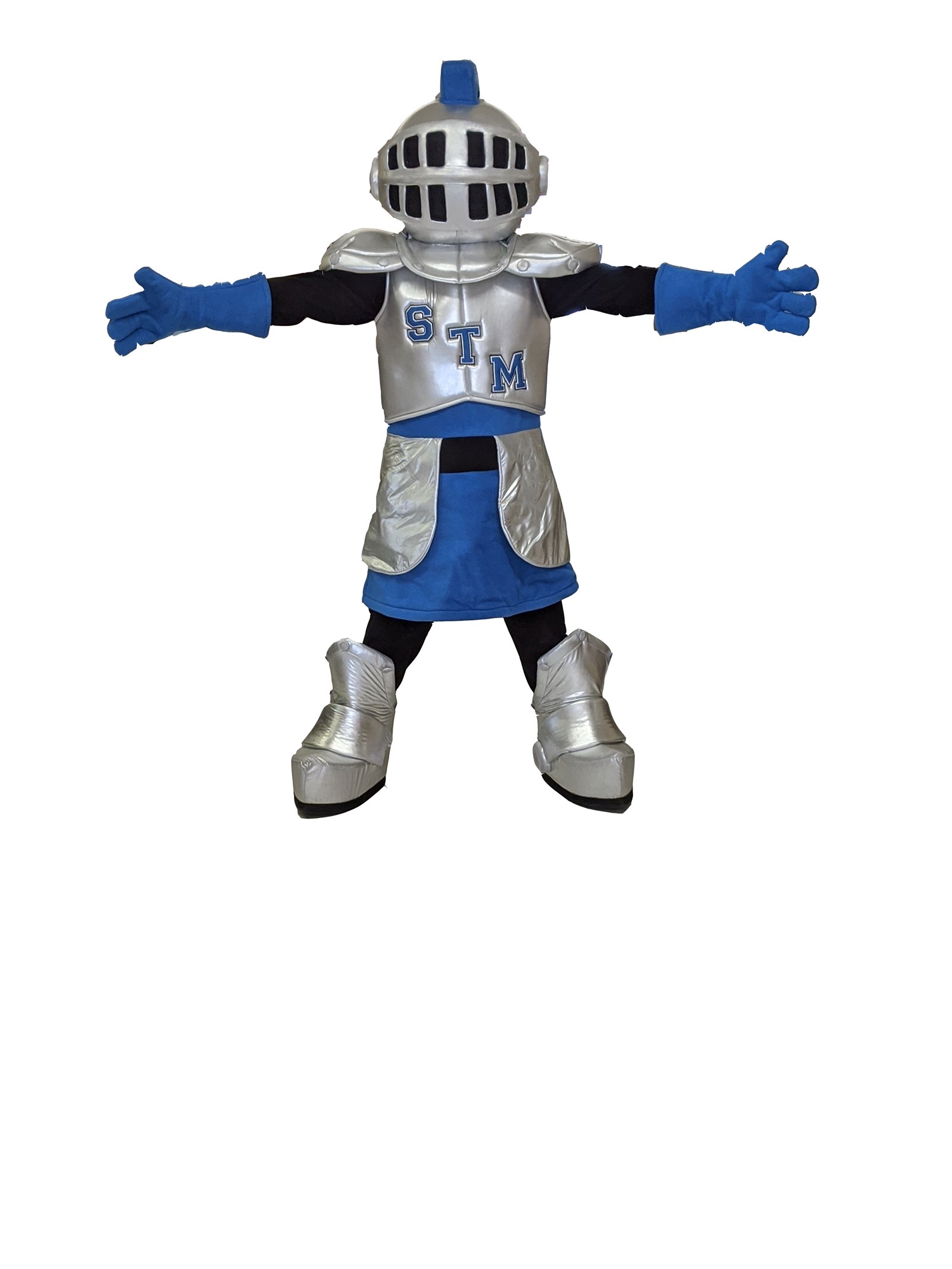
Chosen out of respect for St. Thomas More, who was himself a Knight, our mascot, the Knight, possesses many of the characteristics we strive for in our school:
- We strive to live our core values of dignity and respect, honesty, fairness, loyalty and personal and communal growth.
- We shield and defend the weak and helpless.
- We are guided by principles of justice and fair play in all that we do.
- We are courageous in working toward achieving our goals.
Our School Prayer:
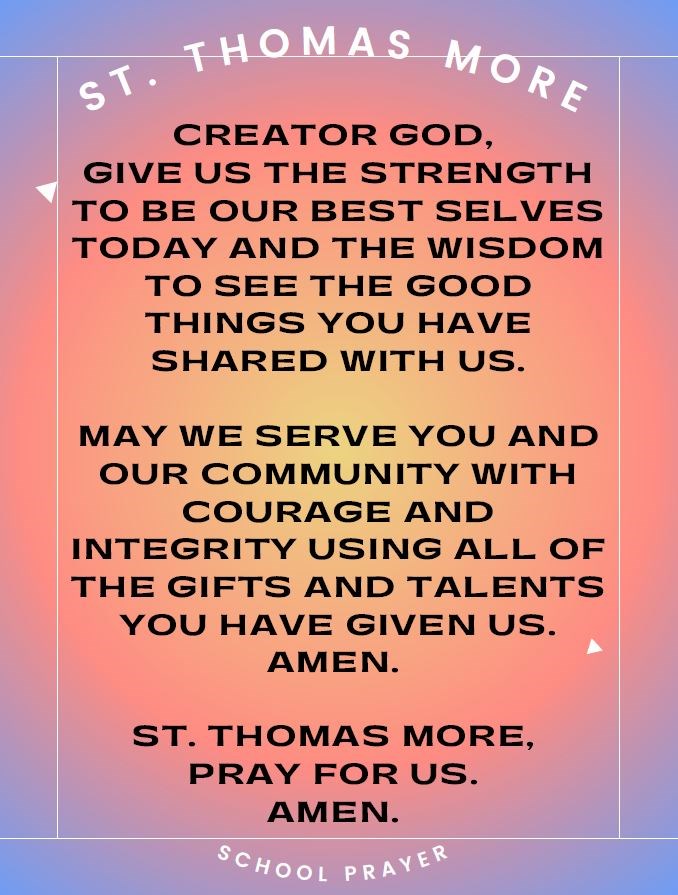
Our Local Parish:
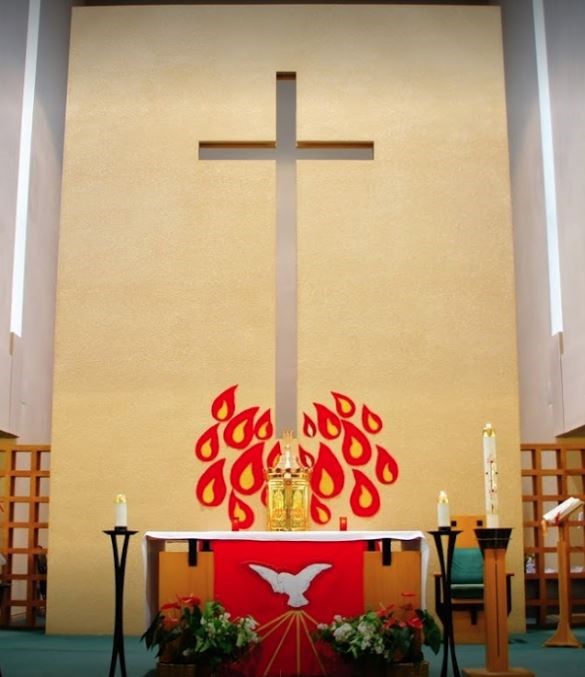
We are so fortunate to be close to our local parish Annunciation Catholic Church. Our school community often celebrates mass at church. Providing this opportunity for student to grow their faith at church is important at our school.
Website: https://annunciation.caedm.ca/
School Assurance Dashboard & Growth Plan
School Hours & Block Times
The office hours are 8 am to 3:15 pm weekdays.
The block times for the 2024-2025 school year are as follows:
School Resource Officer
School Resource Officer
School Resource Officers are community-based police officers with special training who help foster a safe and caring learning environment by prioritizing prevention and intervention over enforcement. Edmonton Catholic Schools currently has 13 SROs serving junior and senior high school students in 17 schools.
The SRO program is a community-based, collaborative partnership between the Edmonton Police Service and Edmonton Catholic Schools.
Who is my School Resource Officer?
Constable Quinton Gamble
What is the role of a School Resource Officer?
The primary responsibility of the School Resource Officer is to work in collaboration with school administration, the school’s multi-disciplinary team, and families to support student safety, growth, and well-being.
ECSD schools benefit from multi-disciplinary teams of which our SROs play an important part. SROs work with a variety of team members that exist within our schools including:
- Student Services Staff
- Grade Coordinators
- Emotional Behavior Specialists
- Family School Liaison Workers
- Psychologists/Clinical Social Workers
- Mental Health Therapists
School Resource Officers contribute to the safety and well-being of students in multiple ways:
- Positive Youth Engagement: School Resource Officers play an important role within the school setting, including organizing and participating in student-led or school activities, providing counselling, mediation and mentoring, and helping to connect students to school and community resources. School Resource Officers are available throughout the day, between classes, during lunch, and before-and-after school, connecting with students beyond the classroom.
- School Safety: SROs work to ensure the safety of students and staff, daily, from planning and executing lockdown drills throughout the school year, to making themselves available for individual or group discussions with students or staff on the topics of school safety, security, and violence. While they are in constant communication with school administrations and staff, they are also the first line of crime prevention in school, helping to deter crime-related incidents, such as bullying, graffiti and vandalism, harassment or stalking, theft, or use of weapons or threats. School safety is not just a response to crisis situations. It is the daily impact of having caring adults who are responsive to a broad range of student and family concerns and how they can support them.
- Resource: SROs offer additional resources to students and families. They can answer questions about law enforcement or assist them to get the resources that they need.
- Education: Working cooperatively with school administrators, staff, students, families, and the community, SROs proactively identify and address school concerns or problems through structured class presentations. These awareness and education sessions are created on a variety of topics (e.g. drug use, healthy relationships and safe driving) and are all tailored to fit the student population based on direct experience of the SRO within the school setting.
Diversion: With their knowledge of the criminal justice system, SROs collaborate with school administration to come up with alternative diversion measures for situations that otherwise may have involved the criminal justice system. This could be anything from completing restorative work around the school, working out with the resource officer, or assisting teachers with extra-curricular activities.

